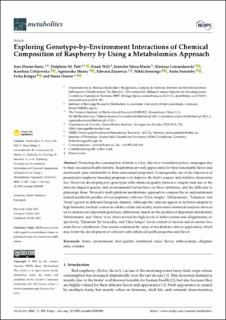| dc.contributor.author | Durán-Soria, Sonia | |
| dc.contributor.author | Pott, Delphine M. | |
| dc.contributor.author | Will, Frank | |
| dc.contributor.author | Mesa-Marín, Jennifer | |
| dc.contributor.author | Lewandowski, Mariusz | |
| dc.contributor.author | Celejewska, Karolina | |
| dc.contributor.author | Masny, Agnieszka | |
| dc.contributor.author | Zurawicz, Edward | |
| dc.contributor.author | Jennings, Nikki | |
| dc.contributor.author | Sønsteby, Anita | |
| dc.contributor.author | Krüger, Erika | |
| dc.contributor.author | Osorio, Sonia | |
| dc.date.accessioned | 2021-10-11T12:30:26Z | |
| dc.date.available | 2021-10-11T12:30:26Z | |
| dc.date.created | 2021-09-13T12:46:48Z | |
| dc.date.issued | 2021-07-28 | |
| dc.identifier.citation | Durán-Soria, S.; Pott, D.M.; Will, F.; Mesa-Marín, J.; Lewandowski, M.; Celejewska, K.; Masny, A.; Żurawicz, E.; Jennings, N.; Sønsteby, A.; Krüger, E.; Osorio, S. Exploring Genotype-by-Environment Interactions of Chemical Composition of Raspberry by Using a Metabolomics Approach. Metabolites 2021, 11, 490. | en_US |
| dc.identifier.issn | 2218-1989 | |
| dc.identifier.uri | https://hdl.handle.net/11250/2789051 | |
| dc.description.abstract | Promoting the consumption of fruits is a key objective of nutrition policy campaigns due to their associated health benefits. Raspberries are well appreciated for their remarkable flavor and nutritional value attributable to their antioxidant properties. Consequently, one of the objectives of present-day raspberry breeding programs is to improve the fruit’s sensory and nutritive characteristics. However, developing new genotypes with enhanced quality traits is a complex task due to the intricate impacts genetic and environmental factors have on these attributes, and the difficulty to phenotype them. We used a multi-platform metabolomic approach to compare flavor- and nutritional-related metabolite profiles of four raspberry cultivars (‘Glen Ample’, ‘Schönemann’, ‘Tulameen’ and ‘Veten’) grown in different European climates. Although the cultivars appear to be better adapted to high latitudes, for their content in soluble solids and acidity, multivariate statistical analyses allowed us to underscore important genotypic differences based on the profiles of important metabolites. ‘Schönemann’ and ‘Veten’ were characterized by high levels of anthocyanins and ellagitannins, respectively, ‘Tulameen’ by its acidity, and ‘Glen Ample’ for its content of sucrose and β-ionone, two main flavor contributors. Our results confirmed the value of metabolomic-driven approaches, which may foster the development of cultivars with enhanced health properties and flavor. | en_US |
| dc.language.iso | eng | en_US |
| dc.publisher | MDPI, Basel, Switzerland | en_US |
| dc.rights | Navngivelse 4.0 Internasjonal | * |
| dc.rights.uri | http://creativecommons.org/licenses/by/4.0/deed.no | * |
| dc.title | Exploring Genotype-by-Environment Interactions of Chemical Composition of Raspberry by Using a Metabolomics Approach | en_US |
| dc.type | Peer reviewed | en_US |
| dc.type | Journal article | en_US |
| dc.description.version | publishedVersion | en_US |
| dc.rights.holder | © 2021 by the authors | en_US |
| dc.source.volume | 11 | en_US |
| dc.source.journal | Metabolites | en_US |
| dc.source.issue | 490 | en_US |
| dc.identifier.doi | 10.3390/metabo11080490 | |
| dc.identifier.cristin | 1933729 | |
| dc.relation.project | EC/H2020/679303 | en_US |
| dc.source.articlenumber | 490 | en_US |
| cristin.ispublished | true | |
| cristin.fulltext | original | |
| cristin.qualitycode | 1 | |

